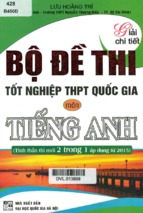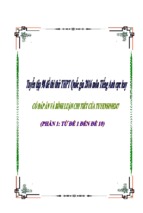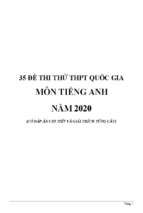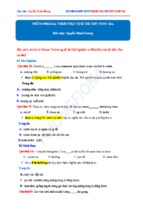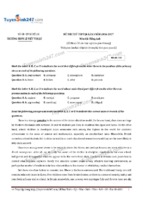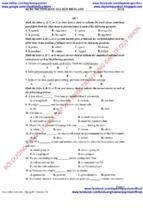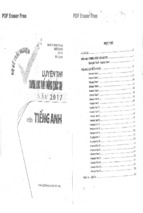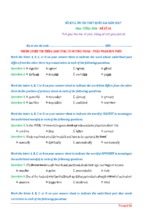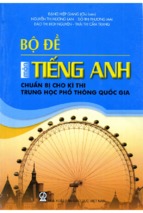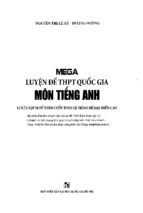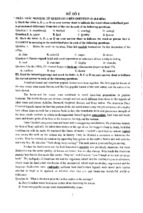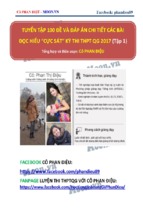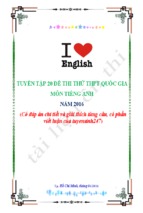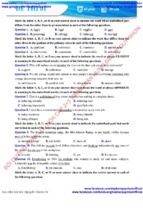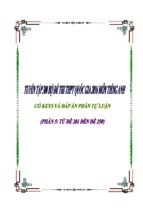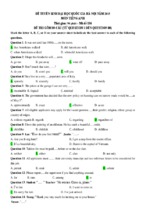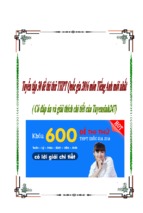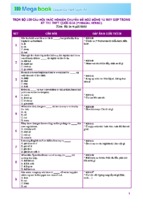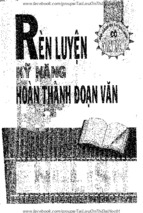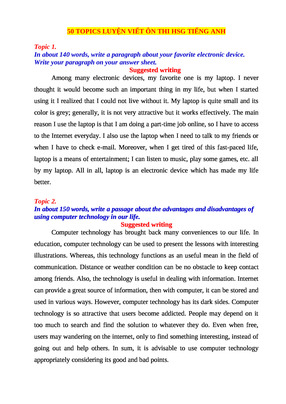ĐỀ THI THỬ SỐ 30
tienganh123.com
ĐỀ THI THỬ ĐẠI HỌC NĂM 2012
Môn: TIẾNG ANH; Khối D
Thời gian làm bài: 90 phút, không kể thời gian phát đề
ĐỀ THI GỒM 80 CÂU (TỪ QUESTION 1 ĐẾN QUESTION 80)
I. Choose the word whose syllable is stressed differently from the others.
Question 1
A.describe
B.society
C.political
D.struggle
Chúng ta có A, B, và C có trọng âm ở âm tiết thứ 2, chỉ có D. struggle là có trọng âm ở âm tiết
thứ nhất.
A. /dis'kraib/ ,
B. /sə'saiəti/
,
C. /pə'litikə/
,
D. /'strʌgl/
Question 2
A. difference
B. immortality
C. politician
D. independence
Trọng âm của “difference” rơi vào âm tiết thứ nhất, các từ còn lại trọng âm rơi vào âm tiết thứ 3.
A. /'difrəns/, B. /,imɔ :'tæliti/, C. /,pɔ li'tiʃn/, D. /,indi'pendəns/
Question 3
A. biology
B. biographer
C. biography
D. bioscope
Trọng âm của “bioscope” rơi vào âm tiết thứ nhất, trong khi các từ còn lại có trọng âm rơi vào
âm tiết thứ 2.
A. /bai'ɔ lədʤi/
B. /bai'ɔgrəfə/
C. /bai'ɔgrəfi/
D. /ˈbʌɪəskəʊp/
Question 4
A. accident
B. accompany
C. access
D. animal
Trọng âm của “accompany” rơi vào âm tiết thứ 2, các từ còn lại có trong âm rơi vào âm tiết thứ
nhất.
A. /'æksɪdənt / B. /ə'kʌmpəni/ C. /'ækses/ D. /'æniməl/
Question 5
A. environment
B. department
C. dependent
D. demonstrate
Trọng âm của “demonstrate” rơi vào âm tiết thứ nhất, các từ còn lại có trọng âm rơi vào âm tiết
thứ 2.
A. /in'vaiərənmənt/, B. /di'pɑ:tmənt/, C. /di'pendənt/, D. /'demənstreit/
II. Mark the letter A, B, C, or D on your answer sheet to indicate the correct answer to each of
the following questions.
Question 6: Oxygen is a __________ gas.
A. poisonous
B. odourless
C. dangerous
D. harmful
Oxy là mô ôt loại khí ……. => chúng ta sẽ loại trừ các đáp án “poisonous” (có đô ôc), “dangerous”
(nguy hiểm), “harmful” (có hại), đáp án đúng sẽ là “odourless” (không mùi).
Question 7: “ Wild-life-preserves”
are areas where wild animals are _______ within their natural environment.
A. hunted
B .threatened
C. protected
D. discarded
“Khu bảo tồn cuô ôc sống hoang dã” là khu vực nơi mà đô ông vâ ôt hoang dã được………trong môi
trường tự nhiên của chúng => căn cứ vào nô ôi dung câu, từ phải điền ở đây là “protected” (được
bảo vê ô) chứ không phải “hunted” (bị săn bắn), “threatened” (bị đe dọa), “discarded” (vứt bỏ).
Question 8: Most forest fires are caused by humans ; _________ are caused by lightning.
A. only a few
B. only few
C. only a little
D. only several
Chúng ta có:
- “a few/ few” dùng với danh từ đếm được, “a little/ little” với danh từ không đếm được
- “few/ little” dùng trong câu chủ đô ông với nghĩa phủ định (có quá ít), “a few/ a little” với nghĩa
“mô ôt vài, mô ôt ít”
Căn cứ vào đó ta có A. only a few (chỉ có mô ôt vài) là đáp án đúng.
Question 9:Hurry up ! We have ________ time to catch the last train home.
A. little
B. a little
C. a few
D. few
Ở đây chúng ta sử dụng “little” đi với danh từ “time” không đếm được, và với ý nghĩa còn quá ít
thời gian để bắt chuyến tàu cuối về nhà.
Question 10: People say that playing football is the most interesting. It means__________.
A. the most important thing is the most interesting.
B. it was said that playing football is the most I nteresting.
C. it is said that playing football was the most interesting.
D. playing football is said to be the most interesting.
Trong câu trên, ta có thể viết lại từ câu chủ đô ông sang dạng bị đô ông với nghĩa không đổi. D là
đáp án đúng ở đây.
Question 11: Your bad result made me __________.
A. disappoint
B. disappointment
C. disappointed
D. disappointing
Chúng ta có cấu trúc “make somebody + adjective” (làm cho ai đó…..) => trong câu trên chúng
ta có 2 tính tư là “disappointed” và “disappointing”, trong đó, để đi với “me” (đối tượng chịu tác
đô ông) chúng ta dùng “disapointed”
Question 12: Car _______ contains carbon monoxide which is invisible but dangerous .
A. rubbish
B. garbage
C. exhaust
D. air
.....xe chứa oxit cacbon, loại khí không nhìn thấy được nhưng nguy hiểm => đáp án sẽ là
“exhaust” ( khi thải) mà không phải “rubbish” /”garbage” (rác thải), “air” (không khí)
Question 13: She was _____ she could not say anything .
A. so surprised at the news that
B. such surprised at the news that
C. so surprised of the news that
D. so that surprised for the news that
Chúng ta có:
- So + adjective + that / such + (a/an) + Noun phrase + that: quá……..đến nỗi……… =>
Chúng ta sử dụng cấu trúc “so…that…” đi với “surprised”.
- Cụm cố định “surprised at”: ngạc nhiên với.
=> A là đáp án đúng
Question 14: “Interpole” comes from the combination of ________________.
A. internet and pole
B. internet and police
C. international and pole
D. international and police
“Interpol” là tên viết tắt của tổ chức Cảnh sát Quốc tế, do đó nó sẽ là từ ghép từ 2 từ
“international” và “police”
Question 15: Would you mind ________ in the theatre ?
A. do not smoke
B. smoke not
C. not to smoke
D. not smoking
Sau cấu trúc “Would you mind” (bạn có phiền) sẽ là mô t đô ng từ ở dạngV-ing.
ô
ô
Căn cứ vào nô ôi dung câu, ta có “Bạn có phiền không hút thuốc ở trong rạp hát được không?” =>
chúng ta có D. not smoking là đáp án đúng.
Question 16: If he pays _________ to what the teacher says , he might make progress.
A. care
B. attention
C. notice
D. sight
Chúng ta có cấu trúc “pay attention to” có nghĩa là “chú ý tới” => B là đáp án đúng.
Question 17: I was doing my homework when the telephone _______ .
A. rings
B. is ringing
C. rang
D. was ringing
Với “when” chúng ta dùng khi nói về mô ôt hành đô ông nào đó đang diễn ra và có mô ôt hành đô ông
khác xen vào, trong câu trên, hành đô ng xen vào sẽ chia ở quá khứ thường => “rang” là đáp án
ô
đúng.
Question 18: Do you remember the day ________ we got lost ?
A. where
B. when
C. whom
D. which
Chúng ta sử dụng đại từ quan hê ô thay thế cho “the day” là chỉ thời gian => “when” là đáp án
đúng.
Question 19: No trees can grow in that soil. It is _______ .
A. treeless
B. restless
C. careless
D. crowded
Treeless (adj): không có cây
Restless (adj): không ngừng nghỉ
Careless (adj): không cẩn thâ ôn
Crowded (adj): đông đúc
=> A là đáp án đúng.
Question 20: “ Did you come to Tom’s wedding party ?”
“No, I would have come there , ______________ me .”
A. if he invited
B. if he had invited
C. if he has invited
D. would he invite
Chúng ta thấy có dấu hiê ôu của câu điều kiê ôn loại 3 ở đây “
would have come”, mê nh đề điều
ô
kiê ôn sẽ chia ở dạng quá khứ hoàn thành => B là đáp án đúng.
Question 21: He dropped the glass and it broke ___________pieces.
A. in
B . off
C. over
D. into
Cụm cố định “break into” ( vỡ thành) là đáp án đúng ở đây.
Break in: đô ôt nhâ ôp vào
Break off: chia cắt
Question 22: Only 489 athletes from 11 nations________ in the 1st Asian Games in New Delhi,
India.
A. joined with
B. concentrated
C. took part
D. struggled
Join with: gia nhâ p vào => không đi với “in”.
ô
Concentrate on: tâ p trung vào
ô
Struggle: vâ ôt lô ôn, giãy giụa
=> đáp án đúng là C. took part in ( tham dư) ô
Question 23: _______he did not attend the English class, he knew the lesson quite well.
A. Despite
B. In spite of
C. However
D. Although
Chúng ta có “Despite/ In spite of” + Noun/ V-ing", do đó ta loại bỏ đáp án A và B.
Theo nghĩa của câu, ta loại bỏ tiếp đáp án C. However => đáp án đúng ở đây là D. Although
(mă ôc dù).
Question 24: I don’t mind__________ waiting for a few minutes.
A. to keep
B. keeping
C. to be kept
D. being kept
Sau “mind” là V-ing.
Dựa vào nghĩa của câu, câu sẽ được chia dạng bị đô ông.
=> “being kept” là đáp án đúng.
Question 25: It is hoped that illiteracy will soon be________ in our country.
A. postponed
B. ceased
C. eradicated
D. decreased
Câu trên có nô ôi dung là Tôi hi vọng rằng nạn mù chữ sẽ sớm được…………ở đất nước chúng ta.
Postpone (v): trì hoãn
Cease (v): ngưng
Eradicate (v): xóa bỏ
Decrease (v): giảm xuống
=> C. eradicated là đáp án đúng
Question 26: He is learning English________ he can study in England.
A. so as to
B. in order
C. in order to
D. so that
“so as to/ in order to” có nghĩa là “để”, sau nó là mô ôt đô ông từ nguyên thể.
Chúng ta có D. so that (+ mê ônh đê) là đáp án đúng.
Question 27: If she hadn’t been sick, she________ with me to the party.
A. would have gone
B. went
C. had gone
D. would go
Câu điều kiê ôn loại 3 => đáp án đúng là “would have gone”.
Question 28: Many people
move from the country are now returning the city.
A. who
B. whose
C. which
D. that
Ở đây, đại từ quan hê ô thay thế cho chủ ngữ “Many people” cho nên đại từ quan hê ô cần điền là
“who”.
Question 29: Parents _________children are in college are working longer hours to pay their
tuition.
A. who
B. whom
C. which
D. whose
“Bố mẹ của những đứa trẻ mà đi học đại học đang làm viêc nhiều hơn để trả học phí cho con”
ô
-> ở đây đại từ quan hê ô còn thiếu phải là “whose” chỉ sự sở hữu.
Question 30: We are looking forward___________a concert.
A. at
B. to
C. for
D. of
Cụm cố định “look forward to + Noun/ V-ing” mang nghĩa mong đợi mô ôt điều gì đó.
III. Choose A, B, C, or D to indicate the sentence that is closest in meaning to each of the
following sentences.
Question 31: Since the weather was so bad , we had to stay at home .
A. When we didn’t go out , the weather was bad.
B. Because of the bad weather, we had to stay at home.
C. If the weather was bad , we couldn’t go out.
D. Although the weather was bad, we went out
Câu gốc: “Vì thời tiết quá xấu, chúng tôi phải ở nha” -> đây là mô t câu sử dụng quan hệ nguyên
ô
nhân, kết quả
A. đảo ngược trâ ôt tự “Khi chúng tôi không ra ngoài, thời tiết trở nên xấu”.
B. đúng về nghĩa và viết lại bằng cấu trúc “because of + Noun phrase”.
C. Câu điều kiê ôn, sai về ý nghĩa, thời tiết xấu là sự thực đã xảy ra, không thể dùng câu điều kiê ôn
“nếu thời tiết xấu,….”.
D. Sai về ngữ nghĩa, “chúng tôi” ở nhà chứ không đi ra ngoài.
Question 32: No one in the team can play better than John.
A. John plays well but the others play better.
B. John as well as other players of the team plays very well.
C. Everyone in the team, but John, plays very well.
D. John is the best player of the team.
Câu gốc “Không ai trong đô ôi chơi tốt hơn John” có nghĩa là John là cầu thủ tốt nhất trong đô ôi.
=> D là đáp án đúng.
Question 33: He only feels happy whenever he doesn’t have much work to do.
A. The more he works, the happier he feels.
B. The less he works, the happier he feels.
C. His work makes him feel happy.
D. He feels happier and happier with his work.
Câu gốc “Anh ta chỉ cảm thấy vui khi mà không có nhiều viêc để mà làm”.
ô
A. Ngược về nghĩa.
B. Đúng về ngữ pháp và ngữ nghĩa “anh ta càng làm ít viê ôc thì anh ta càng cảm thấy vui”.
C. “Công viê ôc làm anh ta cảm thấy vui” không được đề câ ôp trong câu gốc.
D. “Anh ta cảm thấy càng ngày càng hạnh phúc với công viê ôc” cũng là mô ôt thông tin không
được nhắc đến trong câu gốc.
Question 34: She is so fool that she can’t solve the problem.
A. She is too fool not to solve the problem.
B. She is too fool to solve the problem.
C. She is very fool to solve the problem.
D. She is very fool so that she can’t solve the problem.
Câu gốc “Cô ấy quá ngốc đến nỗi mà cô ấy không thể giải quyết được vấn đê”, ở đây sử dụng
cấu trúc “ so…..that…”.
Khi viết lại câu có cấu trúc “so….that….” ta thường dùng cấu trúc “too….to do something”, dựa
vào đó ta thấy “B. Cô ấy quá ngốc để giải quyết cái vấn đê” là đáp án đúng.
Question 35: He earns much money so that his brother can continue taking English course.
A. He earns much money in order for his brother to continue taking English course.
B. He earns much money in order that he can continue taking English course.
C. He earns much money in order to continue taking English course.
D. He earns much money so as to continue taking English course.
Câu gốc “Anh ta kiếm nhiều tiền để em trai có thể tiếp tục theo học khóa tiếng Anh”. Ở đây sử
dụng cấu trúc “so that + mê ênh đê (để mà)
”
Viết lại câu sử dụng cấu trúc “in order to + V”
Ta thấy B, C, D sai về nghĩa, “anh ta” không phải là người tham gia học khóa tiếng anh mà là em
trai, do đó chỉ có A là đáp án đúng.
IV. Choose A, B, C, or D to show the underlined part that needs correction.
Question 36: I gave my address to a man I met him on the train last Sunday.
A. gave
B. to
C. him
D. the train
Câu trên đã được rút gọn từ “a man whom I met on the train…” (người đàn ông mà tôi đã gă p
ô
trên tàu), với đại từ quan hê ô thay thế cho tân ngữta có thể rút gọn bằng cách lược bỏ đại từ quan
hê ô trong câu. Khi đó chúng ta có thể nói “the man I met on the train”. Vì sử dụng mệnh để quan
hệ nên không nhắc lại "him" ở đây nữa.
Question 37: A lot of people will be out of work if the factory were closed down.
A. A lot of
B. will be
C. of work
D. closed down
Ở đây sử dụng câu điều kiê ôn loại 2, mê nh đề chính sẽ sử dụng “would be” chứ không phải “will
ô
be” => đáp án là B
Question 38: They asked me what did happen last night, but I was unable to tell them.
A. asked
B. did happen
C. but
D. to tell
Trên đây là câu tường thuâ ôt có từ để hỏi làm chủ ngữ, sau từ để hỏi “what” sẽ không dùng trợ
đô ông từ, đô ông từ chính sẽ chia dạng quá khứ “what happened” => đáp án ở đây là B.
Question 39: Jim said the switch was dangerous and warned me don’t touch it.
A. said
B. dangerous
C. don't
D. it
Chúng ta có “warrn somebody to do something” (cảnh báo ai đó làm gì), trong câu phủ định sẽ
chuyển thành “warn somebody not to do something” => đáp án ở đây là C (sửa lại thành
“warned me not to touch it”)
Question 40: Many people have complaint about the dirt from the factory.
A. Many
B. complaint
C. about
D. from
Câu trên là câu chia ở thì hiê ôn tại hoàn thành.
Sau “have” đô ông từ sẽ chia ở dạng phân từ 2, do đó B sẽ là đáp án ở đây, “complaint” =>
“complained”
V. Choose A, B, C, or D to indicate the correct answer to each of the following sentences.
Question 41: I was appalled ________ the lack of staff in the hospital.
A. at
B. in
C. on
D. with
Ta có “appalled at” (bị kinh sợ) là cụm cố định => A là đáp án đúng
Question 42: The new President said she would dedicate herself to _____ the rights of the old,
the sick and the homeless.
A. protect
B. protecting
C. protection
D. protected
Ta có cụm “dedicate someone/ something to” (cống hiến) + N/V .
Sau chỗ trống là danh từ nên chỗ trống không thể điền một danh từ => A là đáp án đúng.
Question 43: The air in the country is not as pure as it _______.
A. might be
B. used to be
C. would be
D. must be
“Không khí ở nông thôn không được trong lành như ……”
Might be: có thể
Used to be: như xưa
Would be: sẽ như thế
Must be: phải thế
=> Dựa vào nghĩa của câu, B là đáp án đúng.
Question 44: The police are _________ to the public for any information about the missing girl.
A. attending
B. attracting
C. arguing
D. appealing
Attend (v): tham dự
Attract (v): thu hút
Argue (v): tranh cãi
Appeal (v): tiết lô ô
=> đáp án là D dựa vào nghĩa của câu.
Question 45: The damage was far more serious than ______ believed.
A. prior
B. preceding
C. initially
D. primary
Đứng trước đô ông từ/ tính từ phải là mô ôt trạng từ. A,B, D là tính từ, do đó, đáp án đúng sẽ là C.
Question 46: Asian Games ____________ come from many different countries.
A. athletics
B. athletic
C. athlete
D. athletes
Từ cần điền sẽ là danh từ chỉ người số nhiều, do đó, đáp án đúng là D. athletes.
Question 47: The Asian Games is one of the most important __________ in Asia.
A. incidents
B. events
C. news
D. points
Incident (n): sự viê ôc, vụ việc
Event (n): sự kiê ôn
News (n): tin tức
Point (n): vấn đề
Nói đến Asian Games (Đại hô ôi thể thao Châu Á) là nói đến mô ôt sự kiê ôn quốc tế, do đó đáp án
đúng sẽ là B.
Question 48: We decided to break ____________ tradition and not spend Christmas without
family.
A. up
B. through
C. in
D. with
Break up (v): giải tán
Break in (v): đô ôt nhâ ôp vào
Break with tradition: phá vỡ truyền thống (cụm thành ngữ cố định)
Chúng ta không có “break through” => D là đáp án đúng.
Question 49: Education _______ to be the most important element to develop a country.
A. often be considered
B. can often consider
C. can often considered
D. can often be considered
Ở đây ta sử dụng bị đô ông với chủ ngữ là “education” và đô ông từ khuyết thiếu “can”.
Dạng bị đông với đô ông từ khuyết thiếu “can” có dạng “can be +PII”.
=> đáp án đúng ở đây là D.
Question 50: He works very hard. It's not ___________ that he's always tired.
A. surprised
B. surprising
C. surprise
D. surprises
Từ còn thiếu cần điền vào chỗ trống là mô t tính từ.
ô
Ta có 2 tính từ “surprised” và “surprising”, tuy nhiên “surprised” dùng cho đối tượng là con
người.
=> B là đáp án đúng.
VI. Read the following passage and choose A, B, C, or D to indicate the correct word for each
of the blanks.
The wind controls our planet’s weather and climate, but how much do we understand about
this complex force, which can kill and spread fear?
On the night of 15 October 1987, the South of England was struck by the ___(51)____ winds
it had known for over two hundred years. ____(52)____ of over 130 km/h blew through the
region. Nineteen people were killed, £ 1.5 billion –worth of ___(53)___ was caused and 19
million trees were ____(54)_____ in just a few hours.
Although people thought of this as a hurricane, the winds of 1987 were only ____(55)____
storm force. They are far better known than the much more serious storms of 25 January 1990,
when most of Britain was hit by daytime winds of up to 173 km/h. On this ____(56)____, 47
people were killed, even though unlike in 1987, the weather forecasters issued accurate
____(57)____.
____(58)____ weather events such as these are dramatic reminders of the power of the wind.
It is one part of the weather that people generally do not ____(59)____ a second thought to, but
across the world the wind ____(60)____ a crucial role in people’s lives.
Question 51:
A. heaviest
B. fastest
C. strongest
D. quickest
Ở đây đi với “winds” (gió) chúng ta sẽ không thể sử dụng “heaviest” (nă ông nhất), “fastest/
quickest” (nhanh nhất) mà sẽ phải là “strongest” - những cơn gió “mạnh nhất” trong vòng 200
năm.
Question 52:
A. Blows
B. Hits
C. Clouds
D. Gusts
Blow (n): (sự) thổi
Hit (n): đánh
Cloud (n): mây
Gust (n): Gió mạnh, cuồng phong
=> D là đáp án đúng
Question 53:
A. hurt
B. injury
C. destruction
D. damage
Khi nói đến tình trạng thiê ôt hại tài chính, chúng ta không sử dụng “hurt”/ “injury” (bị thương)
hay “destruction” (sự phá hủy, mà dùng “damage” (thiê ôt hại).
Question 54:
A. blown down
B. cut down
C. knocked down
D. blown up
Ở đây đang nói đến ảnh hưởng của gió đối với cây cối. “cut down” (bị chă ôt xuống), “knocked
down” (bị hạ gục), “blown up” (thổi bay đi) sẽ không thích hợp sử dụng ở đây, chỉ có “blown
down” (bị gió làm đổ gục) là đáp án đúng.
Question 55:
A. powerful
B. severe
C. serious
D. dangerous
Powerful (adj): mạnh mẽ
Severe (adj): khốc liê ôt
Serious (adj): nghiêm trọng
Dangerous (adj): nguy hiểm
=> theo nô ôi dung câu, nói đến tình trạng khốc liê ôt dữ dô ôi của trâ ôn gió, B sẽ là lựa chọn thích
hợp nhất.
Question 56:
A. occasion
B. event
C. accident
D. incident
Chúng ta có thành ngữ “on occasion” là cụm cố định => A là đáp án đúng.
Question 57:
A. threats
B. warnings
C. news
D. signs
Threat (n): sự đe dọa
Warning (n): sự cảnh báo, lời cảnh báo
News (n): tin tức
Sign (n): dấu hiê ôu
Theo nghĩa của câu, những người làm công tác dự báo thời tiết đã đưa ra những cảnh báo chính
xác về cơn cuồng phong, chứ không phải đưa ra lời đe dọa, dấu hiê ôu, hay tin tức => do đó đáp
án ở đây phải là B.
Question 58:
A. Extreme
B. Excessive
C. Extravagant
D. Exaggerate
Extreme (adj): khắc nghiê ôt
Excessive (adj): quá mức
Extravagant (adj): quá mức
Exaggerate (adj): phóng đại
=>theo nghĩa của câu, đáp án sẽ là A “những sự kiê ôn thời tiết khắc nghiê ôt”.
Question 59:
A. have
B. make
C. put
D. give
Chúng ta có “thought” (suy nghĩ), đô ông từ đi với nó sẽ phải là “have” mà không phải là “make/
put/ give”.
Question 60:
A. has
B. makes
C. plays
D. does
Ta có “play a role” (đóng vai trò) là mô ôt cụm cố định => C là đáp án đúng.
VII. Read the following passage and choose A, B, C, or D to indicate the correct answer to
each of the questions.
In the 1500’s when the Spanish moved into what later was to become the South-Western
United States, they encountered the ancestors of the modern day Pueblo, Hopi, and Zuni peoples.
These ancestors, known as the Basket makers, the Anasazi, or the Ancient Ones, had lived in the
area for at least 2000 years. They were an advanced agricultural people who used irrigation to
help grow their crop.
The Anasazi lived in houses constructed of adobe and wood. Anasazi houses were originally
built in pits and were entered from the roof. But around the year 700 A.D., the Anasazi began to
build their homes above the ground and join the together into rambling
multistoried complexes, which the Spanish called pueblos or villages. Separate subterranean
rooms in these pueblos – known as kivas or chapels – were set aside for religious ceremonials.
Each kiva had a fire pit and a hole that was beieved to lead to the underworld. The largest
pueblos had five stories and more than 800 rooms.
The Anasazi family was matrilinear, that is, descent was traced through the female. The
sacred objects of the family were under the control of the oldest female, but the actual
ceremonies were conducted by her brother or son. Women owned the rooms in the pueblo and
the crops, once they were harvested. While still growing, crops belonged to the men who, in
contrast to most other Native American groups, planted them. The women made baskets and
pottery, the men wove textiles and crafted turquoise jewelry.
Each village had two chiefs. The village chief dealt with land disputes and religious affairs.
The war chief led the men in fighting during occasional conflicts that broke out with neighboring
villages and directed the men in community building projects. The cohesive political and social
organization of the Anasazi made it almost impossible for other groups to conquer them.
Question 61: What does the passage mainly discuss?
A. The culture of the Anasazi people
B. European settlement in what became the southeastern United States
C. The construction of Anasazi houses
D. Political structures of Native American peoples
Các câu B, C, và D chỉ là mô ôt phần trong đoạn văn, nô ôi dung đoạn chủ yếu nói về văn hóa của
người Anasazi, do đó A là đáp án đúng.
Question 62: The Anasazi people were considered “agriculturally advanced” because of the way
they…….
A. stored the crops
B. fertilized their fields
C. watered their crops
D. planted their fields
Trong đoạn văn ta thấy có câu:
“They were an advanced agricultural people who used irrigation to help grow their crop.” (Họ là
những người có canh tác nông nghiê ôp tiên tiến mà đã sử dụng tưới tiêu để giúp trồng trọt).
=> đáp án phải là C (tưới nước cho cây trồng).
Question 63: The word “pits” is closest in meaning to
A. stages
B. scars
C. seeds
D. holes
“pit” (hố) = “hole” (n)
Stage (n): đài, bê ô
Scar (n): sẹo
Seed (n): hạt giống
=> D là đáp án đúng.
Question 64: The word “stories” is closest in meaning to
A. articles
B. tales
C. levels
D. rumors
“story” (tầng) tương đương với “level”
Article (n): bài báo
Tale (n): câu chuyê n cổ tích
ô
Rumor (n): lời đồn đại
=> C là đáp án đúng.
Question 65: Who would have been most likely to control the sacred objects of an Anasazi
family?
A. A twenty-year-old man
B. A twenty-year-old woman
C. A forty-year old man
D. A forty-year-old woman
Trong đoạn văn ta có thông tin:
“The sacred objects of the family were under the control of the oldest female” (Các vâ ôt thờ cúng
của gia đình được quản lý bởi người phụ nữ lớn tuổi nhất)
=> trong các đáp án, ta thấy D là đáp án đúng nhất.
Question 66: The word “they” refers to
A. women
B. crops
C. rooms
D. pueblos
Ta có:
“Women owned the rooms in the pueblo and the crops, once they were harvested” (Phụ nữ sở
hữu những căn phòng trong làng và cây trồng, mô ôt khi chúng được thu hoạch”.
=> “they” ở đây thay thế cho “crops” trước nó, do đó, B là đáp án đúng.
Question 67: The word “disputes” is closest in meaning to
A. discussions
B. arguments
C. developments
D. purchases
“dispute” (sự tranh luâ n, bàn cãi) = “argument”
ô
Discussion: thảo luâ ôn
Development: sự phát triển
Purchase: sự mua
=> B là đáp án đúng.
Question 68:Which of the following activities was NOT done by Anasazi men?
A. Making baskets
B. Planting crops
C. Building homes
D. Crafting jewelry
Trong đoạn văn ta có thông tin trong các câu:
“While still growing, crops belonged to the men who, in contrast to most other Native American
groups, planted them” (Trong khi vẫn được trồng, cây trồng thuô ôc về nam giới, người mà trái
ngược với các nhóm người da đỏ khác, trồng chúng)
“The women made baskets and pottery, the men wove textiles and crafted turquoise jewelry”
(Phụ nữ làm sọt và đồ gốm, nam giới dê t sợi và đồ trang sức bằng ngọc”
ô
=> đáp án ở đây là A, “making baskets” là công viê ôc của người phụ nữ chứ không phải nam
giới.
Question 69: According to the passage, what made it almost impossible for other groups to
conquer the Anasazi?
A. The political and social organization of the Anasazi.
B. The military tactics employed by the Anasazi.
C. The Anasazi’s agricultural technology.
D. The natural barriers surrounding Anasazi villages
Chúng ta có thông tin trong câu cuối cùng của đoạn:
“The cohesive political and social organization of the Anasazi made it almost impossible for
other groups to conquer them.” (Tổ chức chính trị và xã hô ôi của người Anasazi làm cho nó trở
nên bất khả xâm phạm đối với những nhóm người khác)
=> A sẽ là đáp án đúng.
Question 70: The passage supports which of the following generalizations?
A. The presence of the Spanish threatened Anasazi society.
B. The Anasazi benefited from trading relations with the Spanish.
C. Anasazi society exhibited a well-defined division of labor.
D. Conflicts between neighboring Anasazi villages were easily resolved.
Trong câu này, ta có thể thấy không có thông tin nào về các câu A, B, và D.
Mă ôt khác, trong đoạn văn, ta thấy được có đề câ ôp đến viê ôc phân chia công viê ôc giữa phụ nữ và
nam giới trong sản xuất nông nghiê ôp, phân chia công viê ôc của thủ lĩnh trong công tác chính trị
và xã hô ôi.
=> C là đáp án đúng.
IX. Read the following passage and mark the letter A, B, C, or D on your answer sheet to
indicate the correct answer to each of the questions from 71 to 80.
Under certain circumstances, the human body must cope with gases at greater – than normal atmospheric pressure. For example, gas pressures increase rapidly during a dive made
with scuba gear because the breathing equipment allows divers to stay underwater longer and
dive deeper. The pressure exerted on the human body increases by 1 atmosphere for every 10
meters of depth in seawater, so that at 30 meters in seawater a diver is exposed to a pressure of
about 4 atmospheres. The pressure of the gases being breathed must equal the external pressure
applied to the body; otherwise breathing is very difficult. Therefore all of the gases in the air
breathed by a scuba driver at 40 meters are present of the air we breathe, usually causes a balmy
feeling of well-being at this pressure. At a depth of 5 atmospheres, nitrogen causes symptoms
resembling alcohol intoxication, known as nitrogen narcosis. Nitrogen narcosis apparently
results from a direct effect on the brain of the large amounts of nitrogen dissolved in the blood.
Deep dives are less dangerous if helium is substituted for nitrogen, because under these pressures
helium does not exert a similar narcotic effect.
As a scuba diver descends, the pressure of nitrogen in the lungs increases. Nitrogen then
diffuses from the lungs to the blood, and from blood to body tissues. The reverse occurs when
the diver surfaces; the nitrogen pressure in the lungs falls and the nitrogen diffuses from the
tissues into the blood, and from the blood into the lungs. If the return to the surface is too rapid,
nitrogen in the tissues and blood can not diffuse out rapidly enough and nitrogen bubbles are
formed. They can cause severe pains, particularly around the joints.
Another complication may result if the breath is held during ascent. During ascent from a
depth of 10 meters, the volume of air in the lungs will double because the air pressure at the
surface is only half of what is was at 10 meters. This change in volume may cause the lungs to
distend and even rupture. This condition is called air embolism. To avoid this event, a diver must
- Xem thêm -

